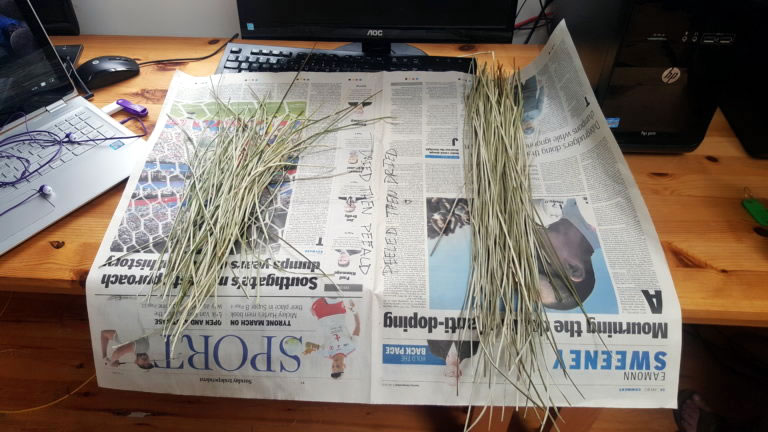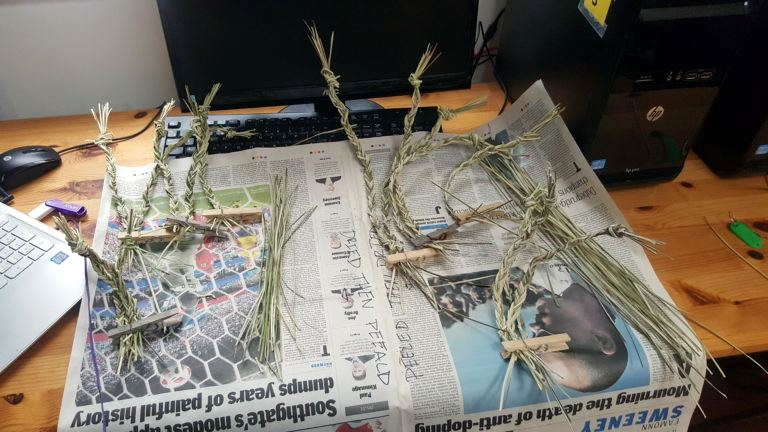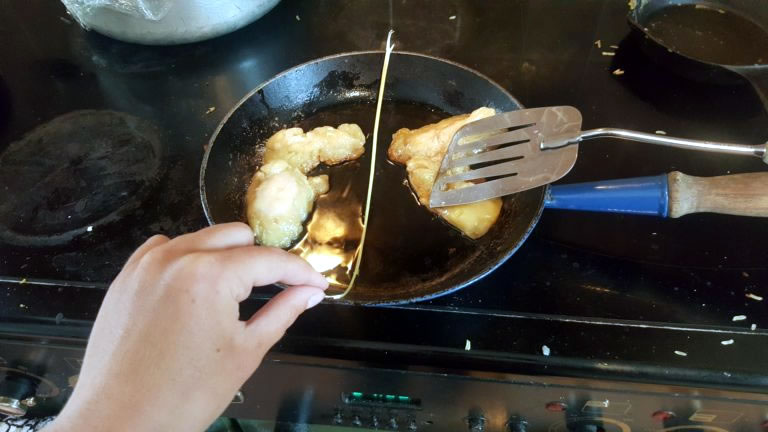By Bridgit Lee
Working here at the Achill Archaeological Field School on early modern vernacular housing for the past two summers, one of the constant questions for me was how were these houses lit? Of course there were the open fires in the houses that would have provided some light to the house but what was used for the more detailed domestic work of sewing and knitting? This question lead me to rush lights. Rush lights are a form of illumination that are strongly associated with rural households in the post-medieval period (Drury 102). To find out some more about how these were made, I went to the National Museum of Country Life where they have some examples of rush lights. I then looked at the School’s Folklore Collection online to find some stories about how they were made.
The general method of making them is fairly easy, or at least it sounds that way. A rush is picked or cut and then peeled of most of the skin, dried, and soaked in animal fat (Ffrench 628). The reality of this process revealed that it was a bit more difficult than it seems at first glance. Starting the adventure meant gathering some rushes. I soon realized why the descriptions I had found said that they would do this with sickles or knives. But having neither of these, I persisted as best I could and managed to gather about two hundred rushes from the Deserted Village on Slievemore. Here is where the descriptions start to differ on what came next. Some said the rushes were dried and then peeled (Mr. Finneran, “Rush Lights and Dip Candles”) while others were firm that the rushes were peeled as soon as they were picked and then dried (“Lights in Olden Times”, Ffrench, Drury). As part of my experiment I decided to split the group in two and have one group peeled immediately, then dry them all, then peel the second group about a week later.

The peeling process took quite a while, partly due to my inexperience with it but I eventually got the hang of it. There is a definite trick to getting the skin off while keeping all of the pith together and clinging to the small strip of skin that is left. Ffrench describes this work as done by the farmer’s wife and mentions that they were sold to those without women in the house to do this work (628). Drury refers to a story referencing rush lights where the making of them is described as women’s work as well (99) though he goes on to say that “the peeling of the rushes was almost invariably the business of the old women and children” (100). Peeling the rushes was certainly a job that was tedious but left plenty of time and concentration for chatting. With all of the rushes prepared and drying, the next step was to procure the animal fat. After visiting three butchers I finally found one who had some lying around and after an awkward conversation about what exactly it was I was doing with it, I departed with a bag of lamb and cow fat. The last step before making the rush lights was to peel the second group and then braid some.

Another point of disagreement among the sources was the idea of single reeds (Drury, Mr. Finneran, “Rush Lights and Dip Candles”, John J. Gallagher) versus groups of reeds that had been braided together(“Lights in Olden Times”, Anne Doherty, Drury). I decided to introduce a second variable and was able to make six braided rush lights per group. All of the rushes soaked up the fat easily and they were then left to dry for another week and a half.

Finally I was ready to light them. See if any of this had actually worked. All of them burned better than I honestly expected them to. They produced a substantial amount of light. The plaited ones even burned well enough to set off the fire alarm. So I only managed to collect data for five of them per group. The plaited sets burned much brighter than the single reeds as I expected and also lasted longer. I was able to read with ease by their light. It was possible to read by the light of the single reeds but I would not really recommend it. It definitely illuminated the room well enough to see everything but detail work would have been a strain on the eyes.

The whole process was a lot of fun and helped to illuminate a part of the daily lives of people in the past. Understanding little details like how the houses were lit and how effective the various lighting methods were helps us to better understand how they lived. It helps us see how space may have been used and what kinds of activities would have been possible. All of this contributes to the story of these people.
References
Doherty, Anne. “Artificial Light”. Collected by Rose Mc Gonigle. The Schools’ Collection, Volume 1122, Page 97. National Folklore Collection, UCD. Accessed 26 July 2018.
Drury, H.C. 1925. “The Rush Light and Its Associates” In The Journal of the Royal Society of Antiquaries of Ireland. 15(2). P.99-111.
Ffrench, J.F.M. 1889-1891. “On a Manner of Lighting Houses in Old Times, Illustrated by Rush-Light Candlesticks” In Proceedings of the Royal Irish Academy (1889-1901). 1. P.626-630.
Finneran, Mr. “The Rush Candle”. Collected by Christina Kelly. The Schools’ Collection, Volume 0230, Page 157. In National Folklore Collection, UCD. Accessed 26 July 2018.
Gallagher, John J. “Local Industries”. Collected by Nellie Gallagher. The Schools’ Collection, Volume 0195, Page 198. National Folklore Collection, UCD. Accessed 26 July 2018.
“Lights in Olden Times” The Schools’ Collection, Volume 0209, Page 531.National Folklore Collection, UCD. Accessed 26 July 2018.
“Rush Lights and Dip Candles” The Schools’ Collection, Volume 0506, Page 027. In National Folklore Collection, UCD. Accessed 26 July 2018
